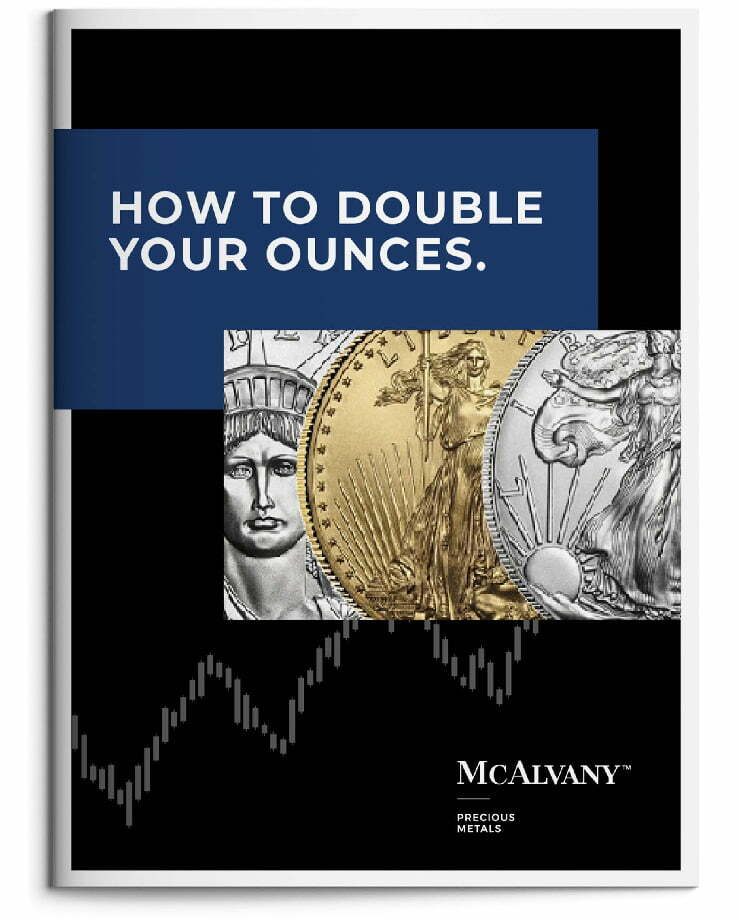Podcast: Play in new window
- Gold & Silver Break Above Historic Numbers
- Lisa Cook & World Perception Of Fed Independence
- All Eyes On September 17th
“You meet the expectations with a 25 basis point cut. You beat the expectations with a 50 basis point cut. You completely blow up expectations and you see a massive equity market hissy fit if you raise rates in light of a powerful, disappointing—to the upside—CPI, PPI report. Gold breaks a four-month consolidation on Friday. Continues through to the upside in Asian and European trading. Silver breaks 40 bucks. Gold miners hit new highs. There are many messages in the market. The question is, are we reading them properly? That’s the trick.” —David McAlvany
* * *
Kevin: Welcome to the McAlvany Weekly Commentary. I’m Kevin Orrick, along with David McAlvany.
David, this has been the strangest market over the last year or two with gold and silver, in that the average retail buyer, they think the stock market’s outperforming gold right now. It’s crazy when I talk to them. It’s like, “gold’s not doing too much.” It’s the central banks. It’s the other buyers. The retail market still has not entered. And gold’s ready to go to new highs.
David: We are at new highs this week, and silver pressing to levels we haven’t seen since 2011, so it is active time in the gold markets. And the airways and front pages of business news rags are full of concern, frankly not over whether Lisa Cook did or did not do something illegal—this is the gal who’s on the Fed FOMC Committee, voting member—but over the circumstances surrounding Bill Pulte’s snooping for dirt on a sitting member of the Federal Reserve Committee. The criminal referrals over mortgage fraud could be taken at face value, and the courts are going to sort out those details. Powell has signaled that he’ll comply with the court’s findings, so if there’s a guilty verdict or whatever, then she’s out. Which is fair, given that accusation’s not the same thing as a guilty verdict. He’s giving it some time. But the concern comes in the context of Trump expressly demanding interest rates come down.
Kevin: There’s a power play here, too. We can’t miss the fact that Trump would like to change the mind of the Federal Reserve.
David: Yeah. He’s on the hunt for a justification to shift who’s on the team. And the hopes are reducing national interest costs and supercharging economic growth. Policy capture is the concern, like the separation of powers between the three branches of government, independence at the central bank is a key to perceptions of legitimacy and trust. So, loss of independence suggests to the global community that the currency of greatest importance on the planet may actually become a policy casualty.
Kevin: Well, you have to admit, though, Dave, this is not something new. The politician has always wanted to influence the central bank, right? I mean, we’ve seen this before.
David: Yeah. Political pressure is recurrent through time. Every administration brings its own version of political pressure. The central bank community is hypersensitive to being seen as compromised or doing the work of legislators or of the executive branch. There are, of course, implications to a central bank not being independent.
Kevin: Would that be inflationism? I mean, just purely printing money?
David: Yeah. A lack of credibility with the central bank shows up in the currency, and it shows up in interest rates. If you’re no longer credible as a manager of money, where does it show up? Foreign currency exchange and the cost to borrow money. So, the implications are real. And you just imagine the inflationism we already have, imagine that on steroids. It’s not as if the central bank bias of the last four decades was wholly unsupportive of policymakers. And this is red and blue. Inflationism is, in my mind, not a debatable issue. We’ve picked an inflation target.
Kevin: All politicians like loose monetary policy.
David: Yeah. And so, the bias has been to promote economic activity via loose and accommodative monetary policy. Both sides of the aisle have winnings from that policy choice. So, loose monetary policy gives legislators as much leash as they can to construct a budget and take care of their constituents. Paper money and easy credit makes for plenty o’ promises to your constituents.
Kevin: Well, I said last week, Dave, that it’s a shame that we have to do what we do. I mean, we’re in the precious metals business. Why in the world should we have to convert our Federal Reserve notes to gold just to protect ourselves from the inflation of the politician?
David: Right. Sound money was the order of the day for many decades, over a century, in terms of the US currency history. The antithesis of inflationism is the gold standard, which constrains spending and credit growth by the very nature of being limited in supply. So, what we are playing with here is not inflationism versus non-inflationism. Again, what is Trump looking for? But if the Federal Reserve is seen as an extension of the Oval Office, then money printing and devaluation become a more serious concern. Fiat as an economic stimulant is one thing. Separation of powers is of utmost importance.
If you go back to how this was scripted by the founders, in Federalist Paper Number 69, Alexander Hamilton addresses the public concern that the president was just another iteration of King George. And he says, “The one,” that is George Washington, “can prescribe no rules concerning the commerce or currency of the country. The other,” meaning King George, “is in several respects the arbiter of commerce.” And yes, of course, King George controlled the mints, creation of money. So, we’ve got 2% inflation, which doesn’t seem to bother anyone anymore. But what could it be if a president ran the printing press, à la King George?
Kevin: So, we concern ourselves with a president necessarily stacking the judicial, stacking the Supreme Court. In a way, what we’re seeing here is the president, President Trump or any president, would like to stack the Federal Reserve in their favor.
David: Absolutely. So, he’s tried and failed the pressure tactics on Powell with the Fed office refurb going over budget. And he’s now creating a situation where if he’s successful and Lisa Cook is ousted from her position, there is an attempt to stack the FOMC board, replacing her with a person set to accommodate the Oval Office’s policy preferences, dovish to be sure.
Kevin: Now, I want to make sure that you clarify, though, Dave. If there is mortgage fraud, she needs to be ousted. But there’s more power play in this than just whether someone’s committed mortgage fraud.
David: Yeah. I think that is one issue. And if you’re looking at it on the surface, that is the issue which Trump is pointing to. The greater concern by the global investment community, the greater concern by those who look at the US dollar as a currency that they settle transactions in, by a reserve community that holds their national treasury in one form or another, US dollars, euros, gold— There’s more at play. And so, I mean, the president appears to believe that if you own the policy rate, you own the economy from a growth perspective. And of course this is a debt guy thinking to himself that if rates are cheap, and that you can get to work on a lot of projects that otherwise wouldn’t pencil out. And of course, he’s right about interest expense being too high, but I think Trump is naive on several other points.
Kevin: Well, wasn’t it the promise back in 1971 when we went off the gold standard, that the dollar would be managed as well as gold was managing the value of the dollar?
David: Yeah. We had no concerns over devaluation. That was Nixon’s ploy, ruse, whatever. I mean, first of all, if Powell is responsible—and this is again where I think Trump is a little naive—if Powell is responsible for the fed funds rate and the economy flourishes, Trump can still take credit for the win. But on the other hand, if the economy slows, Trump can blame Powell for it. That’s the current regime. Trump is apparently willing to give up the game of winning any outcome from the coin toss. The second issue where I think he’s particularly naive is to assume that the yield curve won’t steepen, even if the policy rate—that is, the Fed funds rate—comes down. Just because you stack the OFMC with doves doesn’t mean you get what you want across the entire yield curve.
Kevin: Right. That’s the bond vigilante again, who says, “No, that may work for the short run, but not the long run.”
David: Yeah. And the only way to get that would be via yield curve control. So, there is real rollover risk already embedded in our $37 trillion of obligations. And I’m sure they’re looking and saying it’d be nice to refinance a chunk of that debt at much lower numbers. Yellen should have done that during the pandemic when she could’ve financed 10-year Treasuries at less than one percent. I think the low point was half a percent.
Kevin: And she was still stacking it short.
David: Exactly.
Kevin: Yeah.
David: But if the long end of the curve diverges from the fed funds rate and moves higher despite a lower policy rate, the Treasury is going to be forced to refinance its debt in only short-term paper. She did that voluntarily. Now, they’ll be forced to do it. Of course, it’s large and larger quantities, and that’s where rollover risk concentrates even further.
Kevin: Okay. But you can monetize debt by creating more inflation. I mean, there’s several methods that they use. We’ve even brought up stablecoin as the possibility of getting some money in where we may not be able to sell the Treasuries at the rate that we’re paying, but stablecoin might be a way of directing some funds.
David: It’s important to reflect on Bessent’s criticism of his predecessor, which was to say, you should have refinanced a lot of this stuff when you had the chance. And now he’s playing ball with Trump, and it doesn’t look like he’s going to get to do it either. So maybe he has to be content getting a three, three and a half percent number on debt that’s coming due. But there’s a real issue with oversupply in the Treasury bill market. And if there’s not sufficient demand to facilitate that perpetual rolling of short-term paper, that’s where you can have a shock within the fixed income markets.
Kevin: It’s like they run back to the warehouse and get some more inflation to fix it. That’s yield curve control.
David: Yeah. So you’ll yield curve control, and you mentioned with stablecoins and things like that. You can monetize debt selectively across the curve. There are ways that they’re going to have to deal with this. You can incentivize commercial bank purchases of Treasuries. You can shift the prudent man rules for the investment community to require investor allocations to US debt. As you mentioned, you can soak up excess supply of bills with stablecoin creation and then use the Federal Reserve balance sheet to buy down rates in particular places along the curve.
Kevin: Okay. But there is a price to pay for that. And again, it’s inflation. It’s devalued currency.
David: Yeah. It’s a two-fold price to pay for the sort of market bullying tactics. One is currency devaluation, and two is that parts of the yield curve are going to price in higher inflation risk—in a worst-case scenario, like we had in the 1970s.
Now, we already see some pressure on long bond yields. And this is not just in the US Treasury market. This is globally. So yes, lingering inflation is a part of what is being priced into long bonds around the world, but more importantly, loss of central bank independence all but guarantees a steepening of the yield curve here in the US, undoing any benefit that Trump hopes to get from influencing the Fed. So it really is this fascinating thing. You really want control of the rate, yes. But then the central bank loses credibility. And in losing credibility, you lose control of the rate.
Kevin: Right.
David: It doesn’t really make sense.
Kevin: Well, and the dollar’s already lost, what, 10% this year?
David: 10% year-to-date. And those currency pressures could increase. Arguably they would if the White House was calling audibles on monetary policy. I mean, just think about what goes alongside the indictment of emerging market currencies.
Kevin: Right.
David: The more it looks like a banana republic, the more the currency is appropriately disrespected. And so the 10% decline we’ve seen to date, White House starts calling audibles, and it is a step in the direction of banana republic, at least in the way our currency is treated.
Kevin: And you’re talking about other currencies, but you know what I’ve always loved about gold? It’s the tattletale in the room that will ultimately tell you the truth. And the gold and silver market right now are saying all we need to know about the Fed possibly losing control to political forces.
David: On the day of the announcement—this is the first referral for Lisa Cook—the dollar was off 1.2%. I mean, the dollar was hypersensitive because of the direct implication of loss of central bank independence.
Kevin: Right.
David: And that was literally a knee-jerk reaction.
Kevin: These are people who are going, “I don’t care what she’s done. It looks like the Fed might lose control.”
David: Gold and silver pricing underscore the market’s concern with Trump’s attack on Fed independence. Silver’s over $40. As we said last week, it is in breakout mode. It’s being pulled towards the 50 to $60 mark. And of course, part of that is the inclusion in the critical minerals list that adds extra energy—the possibility—
Kevin: You mentioned that two weeks ago.
David: Yeah, the possibility that that happens. Gold moves above 3,500 for a second time, appears to want to move much higher.
Kevin: Don’t you love the stock market, though? The stock market doesn’t care. They just want to hear good news and buy more. It doesn’t matter how overvalued it is at this point.
David: Yeah, I think equity markets were not showing any weakness as Trump increased the pressure on Lisa Cook, even through the end of last week when he says basically, like he did the apprentice, “you’re fired.”
Kevin: Right.
David: Right? Probably because in a one-dimensional version of the equity chess game, cheap money feeds the levered speculator’s interest, even if it’s only for a short period of time. So if the implication is we get a dovish FOMC board and rates are coming down, that’s good for stocks, they’re really not thinking comprehensively or beyond very short-term measures of success. The implications longer term for the equity markets are actually pretty dire.
Kevin: Well, and you wonder, okay, and I don’t want to make price predictions, but there is a floor to gold and silver. It can only go down so much. There’s not a floor on the currency markets. There’s not a floor on the equity market. Even the bond market could actually just shock people. So with the world’s reserve currency right now being questioned by the world, with good reason if the Fed is being politicized, then is there a ceiling on gold?
David: I think if the world’s reserve currency is in the credibility cross hairs and the largest pool of loans in the world is also facing credibility issues, those are things that certainly do serve as a floor in the metals market. And there is a reasonable question to ask. What is the ceiling?
The fact that interest rate differentials between government bonds—which would typically support the US dollar—have year-to-date signaled the reappraisal of US debt is very interesting. And I think it’s worth lingering on that for a minute because not only have US interest rates been paying more in terms of interest than European bonds, but that has not been a motivation for people to move to US debt.
Kevin: Right.
David: It has not been supportive of the US dollar. And very interestingly, if you look at 2024, typically—and this goes back to the Summers-Barsky thesis—if you get an increase in real rates, there’s real pressure increasing on the gold market.
Kevin: Unless you think that those rates are not keeping up with inflation.
David: Beyond that is this strange behavior circa 2025 where real rates have been improving—real rates. Net of inflation. Real rates have been improving.
Kevin: Right.
David: That has not slowed the gold price at all. So there’s a different character. There’s a different signature in this gold move.
Kevin: It’s a policy change, don’t you think?
David: And a reappraisal of who’s making the policies.
Kevin: But there’s other policies that we also have to look at. There are trade policies at play right now as well.
David: Yeah. And maybe that’s a part of what started to materialize at the beginning of this year and why even though real rates have been on the increase, it has not caused gold to suffer.
Trade policy has been a part of the global reappraisal of US dollar attractiveness. This latest gambit is super interesting. Global reserve managers and global asset allocators have one more reason to assume weak dollar policies will negatively affect their capital.
Again, gold and silver are an easy expression. They’re an obvious expression of that angst. Floating currencies show the angst, but to a lesser degree. Again, gold’s off 10% relative to the euro index. But material changes bring about material concerns. At this point, I don’t think it’s unthinkable that the US dollar revisits its 2008 lows.
Kevin: That’s 25% more of a loss from where we’re at, right?
David: Right. So in fiat currency terms, the US dollar relative to euro is off 10% year-to-date, but gold is up 30% year-to-date. Silver is now up 40% year-to-date. Granted, they’re smaller markets relative to the FX markets, they’re impacted more dramatically, but they are sending a very compelling signal.
Kevin: So that brings me to another point, though, because there are times when you can mess around with interest rates when the markets are sort of medium as far as where they’re at in price. We’re at all time highs. I mean, nosebleed is an understatement.
David: Yeah. I think there is another weakness in Trump’s gambit to control interest rates. Under ordinary circumstances, loose monetary policy floats asset values to higher levels. The issue with that today is that we are already at a very advanced stage in terms of market overvaluation. If you take a composite measure, basically all of the things that we like to talk about individually, lump them together—trailing P/E, forward P/E, the cyclically adjusted price-to-earnings multiple, the ten-year rolling average (sometimes called the Shiller P/E)—
Kevin: How about the Q ratio?
David: Q ratio-
Kevin: Smithers, you talked to Smithers about that.
David: Yeah, price-to-book, market cap to GDP.
Kevin: And you mentioned the Buffett ratio, but where are we at on the Buffett ratio? Last week it was at 218, if I remember right.
David: Yeah, and rising. If you just do a composite of these all together, last week in the equity markets, we exceeded all previous market peaks. The key word there is all.
Kevin: You’re going all the way back to 1929.
David: 1929, 1966, 1999, 2021, all previous peaks.
Kevin: Right.
David: There has never been a more expensive equity market. Again, if you’re just blending these. If you want to pick one out, these are— One’s either even more or somewhat less, but as a blended composite measure, most expensive market ever.
Kevin: When you have a nightmare, sometimes you have nightmares and you go, “Okay, well what did I eat last night?” And a lot of times the joke is, you eat pizza. Well, I ate pizza last night and I had a nightmare this morning. I was just like, “Okay.” But if you think about it, 1929, 1966, 1999, 2021, those all became nightmares for the market. It’s almost like we’re eating pizza right now. With these ratios where they’re at, it’s like, here, go ahead and have that third slice.
David: Yeah.
Kevin: It won’t hurt you.
David: Let’s see how you sleep.
Kevin: Right.
David: Well, risk assets have benefited greatly from the AI bullish narrative—
Kevin: Right.
David: —and obviously from very loose financial conditions. Powell was trying to say, at Jackson Hole, that we have tight financial conditions. The problem with that is the Chicago Fed’s Financial Conditions Index documents that this is one of the loosest set of financial conditions we’ve had in US history.
Kevin: Incredibly loose.
David: Right. His comment’s not even consistent with Fed research on that point, yet the Trump administration wants rates lower. And the assumption is that asset prices continue, and up and to the right—gravity defying moonshot, which I guess of course is possible. Yet we have CPI and PPI, and now PCE, the three measures of inflation, they all suggest inflation is far from dead—
Kevin: Right.
David: —and still far enough off of the 2% target that to further loosen monetary policy, in the context of inflation that’s still percolating higher, is actually quite dangerous.
Kevin: I talked about my love for gold being a tattletale, telling the truth, but you know what also tells the truth in the long run is the long interest rate, the long bond. That’s a truth teller too. I joke about how you read very thick books about interest rate history, but there’s a reason, because that’s where you find the truth.
David: Well, as we laid out in last week’s Commentary, lower Fed funds may not deliver lower long bond rates.
Kevin: Right.
David: And to the degree that spreads widen—either credit spreads, given credit quality, or duration (we talked about duration spread between shorter-dated notes and longer-dated bonds)— If you begin to see those spreads widen, the equity markets become very vulnerable. Given the record holdings of foreign-held US equities, we have to look at the FX market. We have to look at the long bonds as key to assets increasing or decreasing in value, and how foreigners respond. What Trump thinks he can deliver by capturing the Fed board versus what he can actually deliver are not the same thing.
Kevin: And you said this last week, you’re also saying the markets could go much higher. We’re at all-time highs. Nosebleed does not necessarily mean that the nightmare after the pizza’s going to happen right away.
David: Crack-up boom dynamics are basically where everything moves up in value. It’s just a question of what moves up more than something else.
Kevin: Right.
David: Do we have crack-up boom dynamics? It’s possible that we do, in which case it makes it very difficult to be short the market. Everything can go up, and you get no compensation for being short.
Kevin: Right.
David: Gold being a more compelling way to play and manage risk in a portfolio in that environment.
Kevin: With gold, you just wait. You can be wrong in the short run with gold.
David: Yeah.
Kevin: Yeah.
David: Our caveat in recent weeks has been that stocks can move higher in nominal terms along with real estate and other assets if you’ve got a reduction in borrowing costs. The bull market can press considerably higher, even while in real terms—priced in real money, that is inflation-adjusted terms—values are quietly in decline. So you maintain the enthusiasm about stock market investing because an investor opens a statement, and month over month, quarter to quarter, he’s improved his value. Now he’s not doing the currency translation to see that he may be losing his shorts.
Kevin: Right. Literally.
David: Yes.
Kevin: You mean on paper?
David: Yeah.
Kevin: Yeah.
David: Your foreign investor’s going to take note of the inflation-adjusted failure to perform. They’re going to take note of the FX differential—
Kevin: Right.
David: —the foreign exchange differential. And even if in dollar terms you’re moving higher, if it doesn’t translate once they take it back to their home currency— The domestic audience will celebrate nominal gains. They’ll ignore the signal that gold has been sending for some time now. So for me, if I’m placing a bet, it’s that equities follow the dollar lower.
Kevin: So if the dollar—
David: Much lower.
Kevin: Yeah, and much lower, you were saying, to go back to where we were before, 25% lower, would not be unheard of. That’s a lot for a currency. Think about that because if it lowers 25%, you need a stock market that gains at least that or more just to come out.
David: Yeah, 25% decline would take us back to the levels that we were at at the bottom of the global financial crisis, 2008, 2009. That’s where we put in the lows for the dollar.
Kevin: And you’re thinking that’s possible again.
David: I do think that that’s possible, and I think that one of the confusing aspects here is to consider lower equity values and a lower dollar value, but higher nominal prices in equities. That may sound like a contradiction, but this is one of the reasons why I love the Dow/gold ratio.
Kevin: Right.
David: Because the Dow/gold ratio is going to tell you what the truth of—
Kevin: Another truth teller.
David: —performance in equities actually is. So we’re at 13.5 today.
Kevin: We were at 42 back in the year 2000.
David: That’s right. So we’re 2/3 lower.
Kevin: Yeah.
David: We’re 2/3 lower in gold terms, even while we’re setting new nominal highs. Why couldn’t that continue? If we get the Dow to 60,000, but gold trades considerably farther and faster, where the ratio shrinks from 13 and a half to six, a further devaluation—
Kevin: Right.
David: —of equities, a loss in equities of 50% from here is—
Kevin: Relative to gold, yeah.
David: If you’re pricing things nominally, you are lost, and I know this is a painful exercise, mental gymnastics that most people are not flexible enough in their thinking to do or willing to put the time to do, but 13.5 is the current Dow/gold ratio. Just let that sink in. We can find ourselves at a 6:1 ratio—
Kevin: Right, and we’ve seen it.
David: —a 3:1 ratio, a 1:1 ratio.
Kevin: 1:1 twice. Yeah.
David: I’m going to be in New York two weeks from now with my daughter. I’m taking my daughter to the Grant’s Conference, and one of the speakers is Pierre Lassonde. I’m going specifically this year because Pierre is speaking. Pierre Lassonde—
Kevin: A master. A master.
David: —is a master of the gold market.
Kevin: Yeah.
David: He’s master of mine finance, and he’s making the case in his presentation that we get back to gold and the Dow in a 1:1 relationship.
Kevin: Wow. He’s making that case.
David: He’s making that case. That’s the whole presentation at Grant’s Conference is Dow/gold, 1:1.
Kevin: I’ll never forget, 25 years ago, Drew got up and talked about Pierre Lassonde, and he talked about the gold miners. This was 1999, 2000, something like that. Most of these gold mines had pre-sold their gold years out, and Pierre Lassonde said, “No, we’re not going to do that at Franco-Nevada. We’re not going to forward sell our gold. We’re going to just grin and bear it while gold is just hitting these lows.”
David: What he was creatively doing is financing with various mines and gaining access, at low or no future cost, to ounces from those mines. He’s basically saying, “You need money. I have money, and I’ll take a certain percentage of your production for the life of the mine, and I’ll take zero risk in terms of the operations. I’m financing today what will be future ounces at a future goal value.”
Kevin: It was long-term thinking—
David: Yeah, absolutely.
Kevin: —and it really, really paid off. So he’s looking at a 1:1 ratio as well.
I’m going to shift gears, okay, because we talked about impropriety in the Fed. Let’s just call it impropriety.
David: Yeah.
Kevin: What’s different now than in the past, because we’ve seen improprieties with the last administration as well, and people leaving?
David: Oh, sure. And pressure from the Biden administration. We have three Fed members who were forced out over impropriety. They left without any pushback. Of course, Biden was not vocal about pressuring the Fed to do his bidding, so that’s a significant difference. Trump’s rhetoric and overt action is a key differentiator, but yet the Boston Fed President, Eric Rosengren, he resigned over stock trading impropriety. Dallas Fed President Robert Kaplan resigned over stock trading impropriety. Richard Clarida, vice chair of the Federal Reserve, resigned over stock trading impropriety. Lisa Cook has chosen to stay and fight, claiming that the president can’t fire her. “For cause” is the surface issue. And if she committed mortgage fraud, she should resign like the others. Where the circumstances are radically different, the world watches, and the bond and currency markets will not look favorably on a loss of Fed independence.
Kevin: They’re looking at the independent card, not whether she’s guilty or not.
David: It’s not that Fed officials should be unaccountable. It’s the issue of this president pushing as hard as he has for compliance with his preference for lower rates and his pressure tactics. Again, first with Powell, now with Cook, the foreign currency market and the bond community is less interested in the merits of a mortgage fraud case. That’ll sort itself out. It’s more interested in the “what’s next” from the Trump administration because the implications for monetary stability are huge. In play is credibility and trust with two institutions more important than either the president or Lisa Cook. I’m talking about the institutions of the U.S. dollar and the U.S. bond market. Our military is still very important to our global standing.
Kevin: But our military is what supports the dollar. They’re sort of subsidiary to the dollar power.
David: And I frankly think our capital markets are even more critical than our military, impair our capital markets, and we are reduced in terms of our global influence. We’re already being discounted. If you look at our debt and deficits, they’ve been on the radar for some time with our foreign creditors. You add to that concerns over the rule of law, the politicization of monetary policy. These are more nails in the dollar coffin.
Kevin: And last week, you mentioned, there’s some key data coming out, as well as the September 17th meeting with the Fed. So we have some things to look forward to over the next few weeks.
David: Well, this week we have the initial jobless claims and the August unemployment report. Then next week we have August CPI and PPI, which is still a week in advance of the Fed’s September 17th meeting. A very weak employment report will pressure the Fed to lower rates 25 basis points, and there’s a 90% probability that that’s going to happen. That’s already priced into the market. The surprise would be a 50 basis point cut. Really only possible if recession concerns are embedded in the employment numbers. A negative surprise. Maybe we get 50 basis points.
Kevin: What if inflation comes in higher though? I mean, at that point—
David: It depends on how high. It’s a different version of disappointment, right?
Kevin: Right.
David: So disappointing PPI and CPI means that those numbers came in higher than expected. That would provide the FOMC cover for either doing nothing, which today the market’s pricing in a 25 basis points cut. So maybe they don’t have to do anything. And of course that would be incredibly disappointing to the markets. We’re just dealing with expectations.
Kevin: Well, and expectations. I mean, you brought up John Taylor over the last couple of Commentaries.
David: Yeah. What if CPI and PPI end up being higher than expected? Well, according to the Taylor rule, we could actually see a bump in rates, and that would be justified given an increase in the inflation statistics.
Kevin: So Friday, gold and silver broke key resistance and pushed to new highs. What is the market say— Does the market care about September 17th, or is it looking at something else?
David: I mean, I do think the market cares about September 17th because there’s the potential for tanking the equity markets. Again, we come back to upsetting expectations. You meet the expectations with 25 basis point cut. You beat the expectations with a 50 basis point cut. You completely blow up expectations, and you see a massive equity market hissy fit if you raise rates in light of a powerful, disappointing—to the upside—CPI, PPI report. Gold breaks a four-month consolidation on Friday, continues through to the upside in Asian and European trading. Silver breaks 40 bucks. Gold miners hit new highs. There are many messages in the market. The question is, are we reading them properly? That’s the trick.
Kevin: So if I was betting on anything, I’d bet on volatility, then, going into this next month or two.
David: I think we’re set up for a lot of volatility this fall. If Trump wins in his Fed fight, I’m concerned he’ll get more than he bargained for. There is an uncomfortable point coming for Powell, and that is if Cook is ultimately ousted for cause, and Powell has, as he has allowed her to stay at her post, I think Trump redoubles his effort to pressure Powell out of office early. The concerns over Fed independence would then become hysterical. And what does hysterical look like in the foreign currency markets? What does hysterical look like in the bond markets? Trump is playing a power game. He’s definitely playing the bully, and he has a clear idea in mind. Trump’s playing a political game in hopes of juicing the economy and asset prices through the midterms. Nothing new about this.
Kevin: Every president does it.
David: Yeah, that’s a predictable strategy. I think in this context, the stakes couldn’t be higher. With asset prices exceeding the 2021 peaks in many categories and the Everything Bubble expanding, it’s great for Trump now, and he’s willing to pay later—and by pay later, that’s after the midterms. But if the price to pay is now instead of later, his political game becomes much, much more difficult.
* * *
You’ve been listening to the McAlvany Weekly Commentary. I’m Kevin Orrick, along with David McAlvany. You can find us at mcalvany.com and you can call us at (800) 525-9556.
This has been the McAlvany Weekly Commentary. The views expressed should not be considered to be a solicitation or a recommendation for your investment portfolio. You should consult a professional financial advisor to assess your suitability for risk and investment. Join us again next week for a new edition of the McAlvany Weekly Commentary.
















